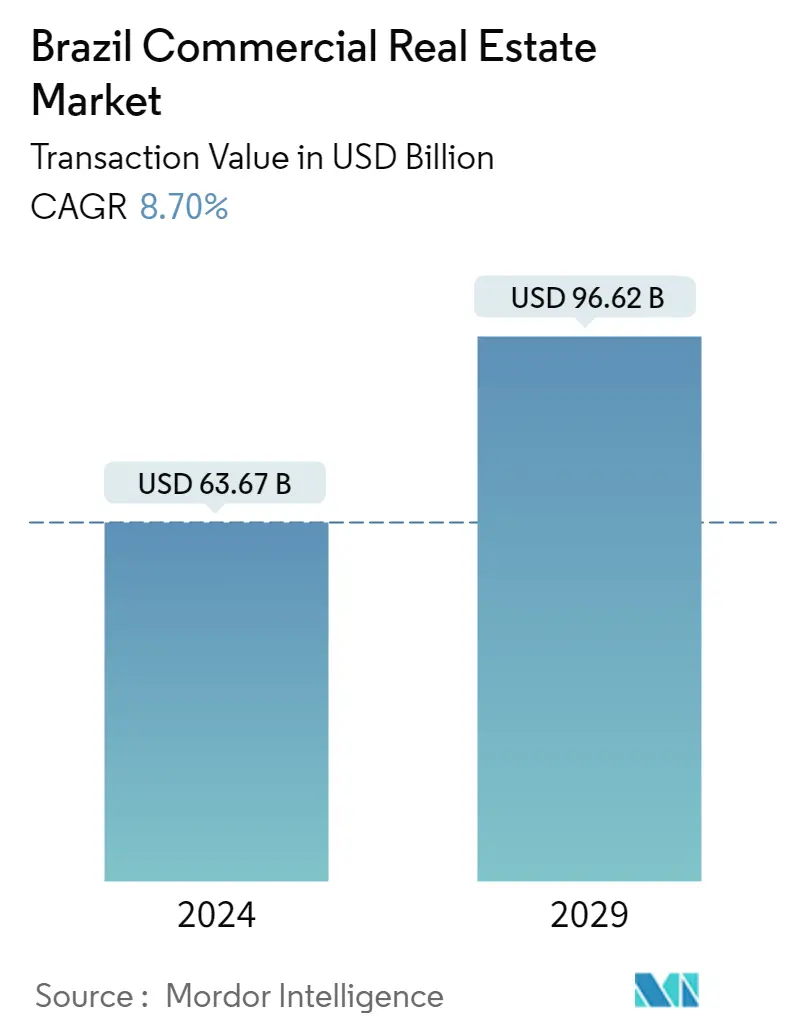Market Size of Brazil Commercial Real Estate Industry

| Study Period | 2019 - 2029 |
| Base Year For Estimation | 2023 |
| Market Size (2024) | USD 63.67 Billion |
| Market Size (2029) | USD 96.62 Billion |
| CAGR (2024 - 2029) | 8.70 % |
| Market Concentration | Low |
Major Players
*Disclaimer: Major Players sorted in no particular order |
Brazil Commercial Real Estate Market Analysis
The Brazil Commercial Real Estate Market size in terms of transaction value is expected to grow from USD 63.67 billion in 2024 to USD 96.62 billion by 2029, at a CAGR of 8.70% during the forecast period (2024-2029).
Brazil has a coastline of 7,491 km, and the Atlantic Ocean borders to the east. It covers 47.3% of the continent's land area and perimeters and all other South American countries except Ecuador and Chile.
The commercial landscape development depends on government policies, such as regulations, taxes, and local planning initiatives. Brazilian real estate developments are regulated by Law 4,591/64. The Securities Commission's Normative Ruling no. 602/18 must also be observed to develop and sell hotel units with the hotel and lease administrations.
In the area of government policy, Brazil has a history of fluctuating policies that impact real estate markets. Tax changes, housing subsidies, and infrastructure investments are expected in 2024. Specific policies could include adjustments to the "Minha Casa Minha Vida" program, which provides affordable housing to low-income Brazilians, or reforms in property tax laws. Depending on their nature, these changes are either stimulating or depressing the property market.
Positive trends include increased foreign investment, growth of the upper classes, and infrastructure development for transport and cities. This improvement can stimulate demand in the real estate market, increasing property value.
Brazil Commercial Real Estate Industry Segmentation
Commercial real estate, investment property, or income property plans to profit from capital gains or rental income. A complete background analysis of the Brazilian commercial real estate market, including the assessment of the economy and contribution of sectors in the economy, market overview, market size estimation for key segments, and emerging trends in the market segments, market dynamics, and geographical trends, and COVID-19 impact, is covered in the report.
The Brazilian commercial real estate market is segmented by type (offices, retail, industrial and logistics, multi-family, and hospitality) and key cities (Rio de Janeiro, Sao Paulo, and the Rest of Brazil). The report offers market size and forecasts for all the above segments in value (USD).
| By Type | |
| Offices | |
| Retail | |
| Industrial and Logistics | |
| Multi-family | |
| Hospitality |
| By Key Cities | |
| Rio de Janeiro | |
| Sao Paulo | |
| Rest Of Brazil |
Brazil Commercial Real Estate Market Size Summary
The Brazilian commercial real estate market is poised for significant growth, driven by substantial investments from large corporations and the burgeoning hospitality sector. The market encompasses a diverse range of investment opportunities, including commercial, residential, and rural land transactions, attracting a myriad of investors, particularly those seeking customized deals for multinational clients. Despite the challenges posed by the COVID-19 pandemic, which initially dampened market performance, efforts to mitigate tax burdens on property transactions and the active development of new projects by both government and private entities have been instrumental in revitalizing the industry. Technological advancements, such as the integration of 3D imaging, virtual reality, and big data analytics, have further bolstered the market's expansion, enhancing operational efficiencies and investment appeal.
The market landscape is characterized by a mix of local and regional players, with prominent companies like Multiplan Empreendimentos Imobiliários SA, Cyrela Commercial Properties SA, and Log Commercial Properties leading the charge. The ongoing political stability and the capital markets' potential are expected to create lucrative opportunities for both local and international investors. The commercial property sector is witnessing a surge in new construction activities, with notable projects like the NH Feira de Santana hotel and the upcoming industrial property in Espírito Santo state underscoring the market's dynamic nature. Despite some vacancies, the Class A office market continues to perform robustly, supported by strong demand in the finance, technology, and health sectors, indicating a resilient recovery and promising future for Brazil's commercial real estate industry.
Brazil Commercial Real Estate Market Market Size - Table of Contents
-
1. MARKET INSIGHTS
-
1.1 Current Economic Scenario and Consumer Sentiment
-
1.2 Commercial Real Estate Buying Trends - Socioeconomic and Demographic Insights
-
1.3 Government Initiatives and Regulatory Aspects for the Commercial Real Estate Sector
-
1.4 Insights into Existing and Upcoming Projects
-
1.5 Insights into Interest Rate Regime for General Economy and Real Estate Lending
-
1.6 Insights into Rental Yields in the Commercial Real Estate Segment
-
1.7 Insights into Capital Market Penetration and REIT Presence in Commercial Real Estate
-
1.8 Insights into Public-Private Partnerships in Commercial Real Estate
-
1.9 Impact of COVID-19 on the Market
-
-
2. MARKET SEGMENTATION
-
2.1 By Type
-
2.1.1 Offices
-
2.1.2 Retail
-
2.1.3 Industrial and Logistics
-
2.1.4 Multi-family
-
2.1.5 Hospitality
-
-
2.2 By Key Cities
-
2.2.1 Rio de Janeiro
-
2.2.2 Sao Paulo
-
2.2.3 Rest Of Brazil
-
-
Brazil Commercial Real Estate Market Market Size FAQs
How big is the Brazil Commercial Real Estate Market?
The Brazil Commercial Real Estate Market size is expected to reach USD 63.67 billion in 2024 and grow at a CAGR of 8.70% to reach USD 96.62 billion by 2029.
What is the current Brazil Commercial Real Estate Market size?
In 2024, the Brazil Commercial Real Estate Market size is expected to reach USD 63.67 billion.

